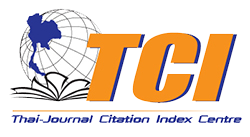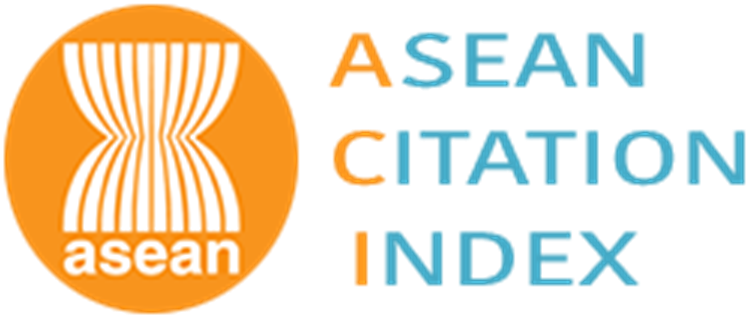ความสัมพันธ์ของจุดความร้อนในพื้นที่ภาคเหนือตอนบนของประเทศไทยและพื้นที่โดยรอบต่อค่าความเข้มข้น PM2.5: กรณีศึกษาช่วงฤดูหมอกควัน ปี พ.ศ. 2562
Relationship of Fire Hotspot, PM2.5 Concentrations, and Surrounding Areas in Upper Northern Thailand: A Case S
Abstract
การวิจัยนี้มีวัตถุประสงค์เพื่อศึกษาผลกระทบของปริมาณจุดความร้อนต่อค่าความเข้มข้น PM2.5 ในพื้นที่ภาคเหนือตอนบนของประเทศไทย ช่วงวันที่ 1 มกราคม – 31 พฤษภาคม พ.ศ. 2562 โดยวิเคราะห์ปริมาณและความหนาแน่นจุดความร้อนในพื้นที่ศึกษาและพื้นที่โดยรอบ วิเคราะห์ความสัมพันธ์ตามเวลาและสัมประสิทธิ์สหสัมพันธ์ (r) ของค่าความเข้มข้น PM2.5 กับปริมาณจุดความร้อนจากภาพถ่ายดาวเทียม และข้อมูลตรวจวัดปัจจัยทางอุตุนิยมวิทยาจาก 9 สถานี ผลการวิจัยพบว่า จุดความร้อนในพื้นที่ศึกษามีปริมาณเพิ่มสูงในช่วงที่ค่าความเข้มข้น PM2.5 อยู่ในเกณฑ์ส่งผลกระทบต่อสุขภาพ โดยพบหนาแน่นสูงบริเวณรอยต่อระหว่างจังหวัด พื้นที่ป่าและพื้นที่เกษตรใกล้เคียง ส่วนพื้นที่โดยรอบพบจุดความร้อนหนาแน่นสูงบริเวณใกล้กับพื้นที่ศึกษาในทางเหนือ ความเข้มข้น PM2.5 ของสถานีส่วนใหญ่มีค่าสอดคล้องกับจุดความร้อนของพื้นที่โดยรอบมากกว่าจุดความร้อนของจังหวัด ซึ่งเห็นได้จากค่า r ที่สอดคล้องกันในเกณฑ์ปานกลาง-สูง (r = 0.5 – 0.7) ส่วนจุดความร้อนของจังหวัดสอดคล้องกับค่าความเข้มข้น PM2.5 เช่นกัน ด้วยค่า r ที่น้อยกว่า ซึ่งแสดงให้เห็นถึงอิทธิพลของแหล่งกำเนิดจากพื้นที่โดยรอบที่ส่งผลต่อค่าความเข้มข้นในพื้นที่จังหวัดนั้น ๆ ค่าความเข้มข้น PM2.5 ในสถานีส่วนใหญ่แปรผกผันกับปัจจัยปริมาณน้ำฝนและความเร็วลม
The objective of this research is to study the effects of thermal hotspots on PM2.5 concentrations in the upper northern of Thailand during 1 January–31 May 2019. The number and the density of fire hotspots of the examined and adjacent areas was investigated. The time-series relationships between PM2.5 concentrations, the number of satellite-based fire hotspots, and meteorological factors derived from 9 stations were analyzed. As results, the greater number of hotspots was correlated with increased levels of PM2.5 concentrations. Such conditions exhibit considerable impacts on health. High PM2.5 concentrations were specifically found around provincial boundaries, in forests, agricultural areas, as well as in Thailand’s neighboring countries. As for the surrounding areas, the areas that have high density of fire hotspots were found near investigated areas in the north region. Provincial fire hotspots were correlated to high PM2.5 concentration, with a lower r-value. The thermal hotspot locations from the surrounding areas have effects on provincial PM2.5 concentrations. Finally, the effect of meteorological factors on PM2.5 concentrations was analyzed. As a result, precipitation and wind speed have inverse effects on PM2.5 concentrations.
Keywords
[1] Pollution Control Department (2018). Air pollution from smog. [Online] (in Thai). Available: http:// pcd.go.th/Info_serv/air_thaihaze.html
[2] State of Global Air (2019). Explore the Data. [Online]. Available: https://www.stateofglobal air.org/data/#/health/plot
[3] Epidemiology & Intelligence Section. (2017, Apr.). Report on the situation and operations to resolve the smog problem in medicine and public health. Department of Disease Control. Lampang, Thailand. [Online] (in Thai). Available: http://odpc1.ddc.moph.go.th/epidpc10/ list_report.php?item_id=3
[4] S. Dontree. (2019). Thailand Free of Smog: Look at Policy and Solutions. [Online] (in Thai). Available: http://doh.hpc.go.th/data/PM25/ thailandNoSmog.pdf
[5] L. Pardthaisong, P. Sin-ampol, C. Suwanprasit, and A. Charoenpanyanet. Haze pollution in Chiang Mai , Thailand: A road to resilience. 7th International Conference on Building Resilience; Using scientific knowledge to inform policy and practice in disaster risk reduction. [Online]. Available: https:// www.sciencedirect.com/science/article/pii/ S1877705818300213?via%3Dihub
[6] Pollution Control Department. (2017). Northern Haze Prevention and Solution Action Plan. Ministry of Natural Resources and Environment. [Online] (in Thai). Available: http://infofile.pcd. go.th/air/northair_actionpln20170207.pdf?CFID =2437604&CFTOKEN=22218289
[7] C. Chotamonsak and D. Lapyai. (2018, October). Meteorological factors related to air pollution in Chiang Mai province. Journal of Research Unit on Science, Technology and Environment for Learning. [Online] (in Thai). 9(2), pp. 237–249. Available: http://ejournals.swu.ac.th/index. php/JSTEL/article/view/11067
[8] NASA Official. (2019). Active Fire Data. [Online]. Available: https://earthdata.nasa.gov/earthobservation- data/near-real-time/firms/activefire- data.
[9] B. Maccherone. MODIS. [Online]. Available: https://modis.gsfc.nasa.gov/about/
[10] P. Nokkasem, “Factors affect to concentrations of TSP and PM-10 created from paddy drying field,” M.S. thesis, Department of Environmental Science, Faculty of Science and Technology Thammasat University, 2007 (in Thai).
[11] P. Punsompong and S. Chantara. (2018, April). Identification of potential sources of PM10 pollution from biomass burning in northern Thailand using statistical analysis of trajectories. Atmospheric Pollution Research. [Online]. 9(6), pp. 1038–1051. Available: https://www. sciencedirect.com/science/article/abs/pii/ S130910421730630X?via%3Dihub
[12] Y. Xiang, T. Zhang, J. Liu, L. Lv, Y. Dong, and Z. Chen. (2018, September). Atmosphere boundary layer height and its effect on air pollutants in Beijing during winter heavy pollution. Atmospheric Research. [Online]. 215, pp. 305–316. Available: https://www. sciencedirect.com/science/article/pii/ S0169809518307130?via%3Dihub
[13] Geo-Informatics and Space Technology Development Agency. (2019, August). Summary of forest fires and smog With satellite images of the year 2019. [Online] (in Thai). Available: http://fire.gistda.or.th/fire_report/Fire_2562.pdf
[14] L. Giglio, W. Schroeder, J. V. Hall, and C. O. Justice. (2018, December). MODIS Collection 6 Active Fire Product User’s Guide Revision B. (2nd ed.) [Online]. 1. Available: https://modis-fire.umd. edu/files/MODIS_C6_Fire_User_Guide_B.pdf
[15] Land Development Department. (2019). Land use in Thailand year 2017–2018. [Online] (in Thai). Available: http://www1.ldd.go.th/ web_OLP/result/luse_result60-61.htm
[16] ESRI. (2020). How Kernel Density works. [Online]. Available: https://pro.arcgis.com/en/pro-app/ latest/tool-reference/spatial-analyst/howkernel- density-works.htm
[17] Stephanie Glen. (2021). Correlation Coefficient: Simple Definition, Formula, Easy Steps. [Online] (in Thai). Available: https://www.statisticshowto. com/probability-and-statistics/correlationcoefficient- formula/#Excel
[18] United States Environmental Protection Agency. (2012). The National Ambient Air Quality Standards for Particle Matter: Revised Air Quality Standards for Particle Pollution and Updates to the Air Quality Index (AQI). [Online]. Available: https://www.epa.gov/sites/ production/files/2016-04/documents/2012_ aqi_factsheet.pdf
[19] NOAA PSL. (2021). Multivariate ENSO Index Version 2. [Online]. Available: https://psl.noaa. gov/enso/mei/
[20] C. Chotamonsak and D. Lapyai. (2018, September). The Effects of biomass burning aerosols on solar radiation and climate over Northern Thailand: A case study of the 2013 Smoke-Haze Season. Burapha Science Journal. [Online] (in Thai). 23(3), pp. 1268–1283. Available: http://ojslib3.buu.in.th/index.php/science/ article/view/5804
[21] M. Zeeshaan, I. Shahid, F. Chishtie, and M. Imran. (2018, December). Analysis of a dense haze event over North-eastern Pakistan using WRF-Chem model and remote sensing. Journal of Atmospheric and Solar-Terrestrial Physics. [Onlne]. 182, pp. 229–241. Available: https:// www.sciencedirect.com/science/article/abs/ pii/S1364682618303559?via%3Dihub
DOI: 10.14416/j.kmutnb.2022.07.002
ISSN: 2985-2145





